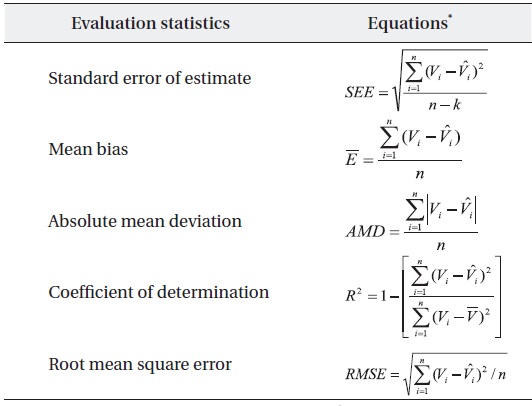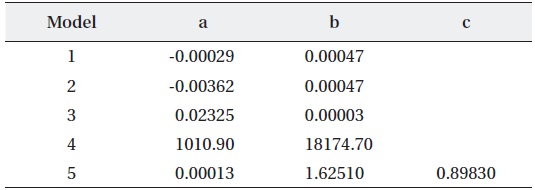



This study was conducted to develop stem volume models for the volume estimation of Quercus glauca Thunb. in Jeju Island, Republic of Korea. Furthermore, this study validated the developed stem volume models using an independent dataset. A total of 167 trees were measured for their diameter at breast height (DBH), total height and stem volume using non-destructive sampling methods. Eighty percent of the dataset was used for the initial model development while the remaining 20% was used for model validation. The performance of the different models was evaluated using the following fit statistics: standard error of estimate (SEE), mean bias absolute mean deviation (AMD), coefficient of determination (R2), and root mean square error (RMSE). The AMD of the five models from the different DBH classes were determined using the validation dataset. Model 5 (V = aDbHc), which estimates volume using DBH and total height as predicting variables, had the best SEE (0.02745), AMD (0.01538), R2 (0.97603) and RMSE (0.02746). Overall, volume models with two independent variables (DBH and total height) performed better than those with only one (DBH) based on the model evaluation and validation. The models developed in this study can provide forest managers with accurate estimations for the stem volumes of Quercus glauca in the subtropical forests of Jeju Island, Korea.
Accurately estimating the volume of trees has always been a very important interest for forest managers (Tewari and Kumar 2001). For instance, stem volume estimation for standing trees is essential in the assessment of forest biomass. According to several authors (Fang and Wang 2001, Lehtonen et al. 2004, Vallet et al. 2006, Tobin and Nieuwenhuis 2007), volume estimates can be used to determine the biomass of the whole tree by using stem density and biomass expansion factor. Furthermore, stem volume estimates are required for sustainable forest management (Hofstad 2005, Haywood 2009). They are also essential for sustainable forest resources planning (Zianis et al. 2005), assessment (Guendehou et al. 2012) and environmental studies (Hofstad 2005). Stem volume can be estimated with field measurements of diameter at breast height (DBH) and total height and by allometric equation development (Teshome 2005, Akindele and LeMay 2006, Gonzalez-Benecke et al. 2014). According to Avery and Burkhart (2002), volume equations are used to estimate the average content of standing trees of various sizes and species.
Jeju Island has a total land area of 184,840 ha and approximately 88,874 ha (48%) of this island has a forest cover (Korea Forest Service 2012). Jeju Island is internationally recognized for its biodiversity. It was designated as a biosphere reserve by the United Nations Educational, Scientific and Cultural Organization on December 2002 (UNESCO 2014). One of the most important forests in this island is the Gotjawal forest, which is conserved and protected due to its unique ecosystem. One such ecosystem is the Dongbaekdongsan wetland, which is designated as a National Wetland Protected Area by the Ministry of Environment of the Republic of Korea and classified as a Ramsar site (Ramsar Convention 2014). Gotjawal forest has a total land area of 11,000 ha, accounting for 6% of the total land area of Jeju Island (Kang et al. 2013) and is situated on the middle slopes of Mount Halla, the highest mountain in the Republic of Korea. Furthermore, Kang et al. (2013) stated that this forest has very significant roles in establishing biological and cultural diversity while maintaining its ecosystems. One of the most dominant tree species in the forest is
Jeju Island is located in the southernmost part of the Republic of Korea, between 126°08′43″ to 126°58′20″E and 33°11′27″ to 33°33′50″N (Lee et al. 2009) as shown in Fig. 1. Broadleaved forests comprise the majority of the forestland of Jeju Island with 30,538 ha. The study site is located in the Gotjawal forest, which is classified as a subtropical forest (Korea Forest Research Institute 2014). The elevation of the sampling areas ranges from 86-235 m above sea level. The mean annual temperature (MAT) of the island is 15.80℃. In addition, the minimum MAT is 12.90℃ and the maximum MAT is 18.90℃(1981-2010). The mean annual precipitation is 1,497.60 mm (Korea Meteorological Administration 2014).
>
Data collection and analysis
The DBH (cm) and total height (m) of the 167 sample trees of

Summary of observed statistics of the data used in the development of stem taper models for Quercus glauca in Jeju Island, Korea
Five common volume equation forms used in various forestry literatures (Clutter et al. 1983, Avery and Burkhart 1994, van Laar and Akça 1997) were selected as candidate models to estimate the stem volume outside the bark of

The five volume equations used in the model development and validation for Quercus glauca in Jeju Island, Korea
[Table 3.] Fit statistics used to assess the performance of the different volume models

Fit statistics used to assess the performance of the different volume models
>
Initial modeling and validation
Using 80% of the dataset, the initial volume model development was completed with five candidate volume equations. The results of the evaluation showed that the
To better determine which model provided the most accurate estimation of stem volume, model validation was conducted. The
The two datasets were combined for final modeling and evaluation. The parameter estimates of the five candidate models were estimated and are shown in Table 4. Using the five fit statistics, the performance of these models were evaluated as shown in Table 5. Model 5 still provided the best
[Table 4.] Parameter estimates of the volume models fitted for Quercus glauca in Jeju Island, Korea

Parameter estimates of the volume models fitted for Quercus glauca in Jeju Island, Korea

Fit statistics of the different volume models fitted for Quercus glauca in Jeju Island, Korea
Kozak and Kozak (2003) recommended using lack-of-fit statistics to determine further which of the candidate models is the most suitable for predicting stem volume. In this evaluation, one or more evaluation statistics must be determined for the various subgroups of the independent variable utilizing the entire dataset. In this study, SEE, and

The lack-of-fit statistics in the different diameter at breast height classes of the candidate models in estimating the total volume of Quercus glauca in Jeju Island, Korea
Overall, models with DBH and height as predictors had better performance than the two models with only DBH as a predictor. This result is comparable to other studies (Tewari and Kumar 2001, 2003, Guendehou et al. 2012) which showed that models with two predictors (DBH and height) had better predictive capabilities than those with only one predictor (DBH) based on the fit statistics.
Although models 1 and 2 had lower performance in stem volume prediction, these two models are still effective, especially when the total height of the tree is unavailable. For instance, the Korea Forest Service conducted the 5th National Forest Inventory (NFI) from 2006-2010 in the Republic of Korea and only 10 representative trees in a plot were measured for total height due to the difficulty and high cost of height measurement, whereas the DBH of all of the trees were measured. Furthermore, Segura and Kanninen (2005) recommended developing volume models using only DBH as a predictor because it can be measured easily and accurately in the field, unlike the total height.
Stem volume models with two predictors, DBH and total height, showed better predictive capability compared to the two models with only one independent variable (DBH) when estimating the volume outside the bark of








